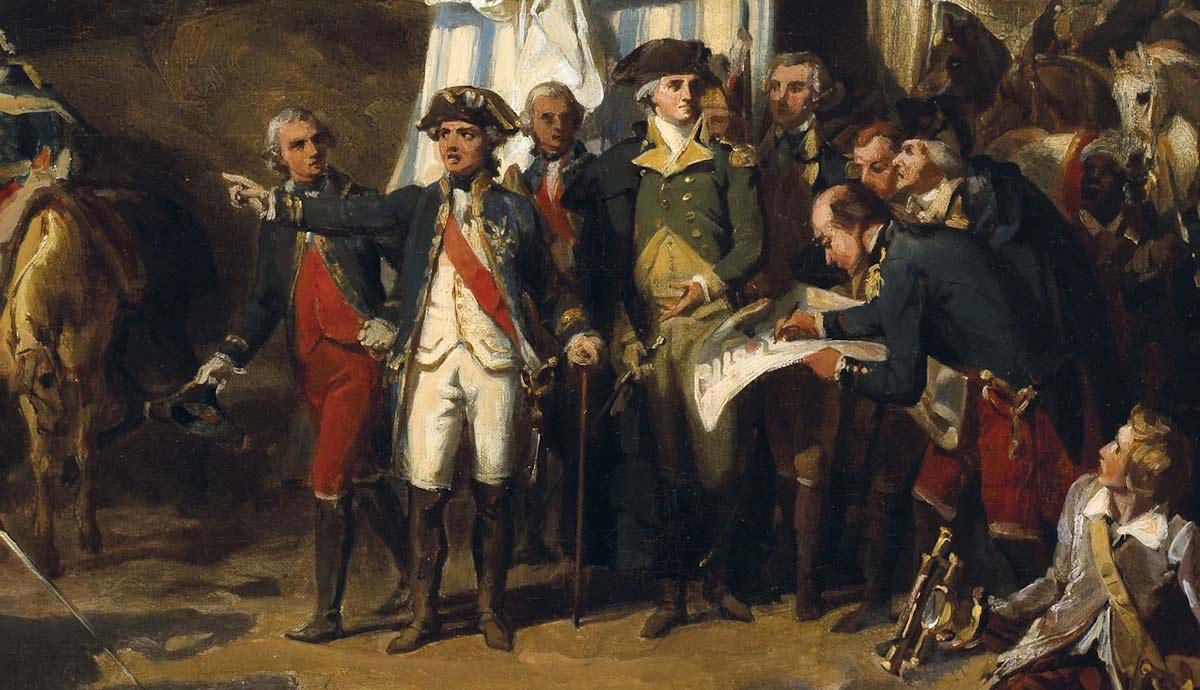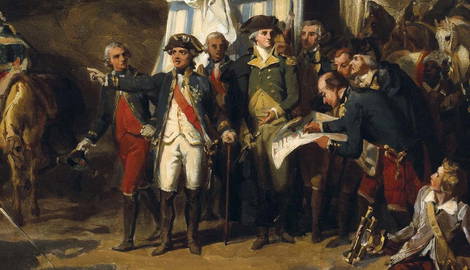
For more than five long years, the American Revolutionary War had been fought across the colonies. The conflict had taken its toll, tearing families and communities apart and driving a massive wedge between those who supported the crown and those who wanted an independent United States.
Britain, too, was weary of the war. The long journeys across the Atlantic were only the beginning, and soldiers suffered from attrition and disease. Seeking to regain the upper hand in a conflict that was dragging on, a major British army retired to the Yorktown peninsula to await reinforcements in order to launch a renewed offensive. The reinforcements would never arrive.
The outcome would be a nail in the coffin for Britain’s attempt to pacify the colonists.
Before the Battle

After five years of fighting, a sizable portion of the British army, approximately 7,500 soldiers, retired to the coast of Virginia. The British had suffered a string of reversals and setbacks that required a reassessment of the strategic situation. From Yorktown, the British, under the command of General Cornwallis, planned to resupply and relaunch their campaign against the Americans.
The French, however, were by this time providing invaluable support to the Continental Army, most notably in the form of a powerful fleet, a luxury that the Americans had been desperately needing since the beginning of the war. The British were a powerful force on the waves, and with the help of the French, Washington hoped that he could dislodge the British from their fortified position in a single decisive blow.
Cornwallis had hoped the British control of New York City would pin down the Americans and buy enough time for the British in Virginia to be reinforced from across the Atlantic. Facing the British in Virginia were 4,500 French troops under the command of Marie-Joseph Paul Yves Roch Gilbert du Motier de La Fayette, Marquis de La Fayette (or simply “Lafayette”), not nearly enough to besiege the British in their fortified positions.
Meanwhile, in 1780, another force of 5,500 French soldiers had landed in Rhode Island to assist the Americans in dealing with the British presence in New York. Washington wanted to attack these positions, but the French commander Marshal Jean-Baptiste, Comte de Rochambeau, considered this plan too difficult, and he convinced Washington to attack the British in Virginia instead.

After receiving word of support from François Joseph Paul, Comte de Grasse, Marquis of Grasse-Tilly (or simply “De Grasse”), who commanded the French fleet in the West Indies, Washington pondered whether to stick to the attack on New York or move south to Yorktown.
With assurances from the Spanish that they would protect the French merchant ships previously protected by De Grasse’s fleet, De Grasse was able to bring his entire fleet to bear upon the British to the northwest.
Cornwallis’s superior, Sir Henry Clinton, was angered by Cornwallis’s strategy, and there seems to have been confusion as to the interpretation of the orders. Clinton was unsure whether Yorktown could be resupplied effectively. Nevertheless, he sent a fleet of ships to safeguard the Virginian coastline and resupply Cornwallis’ forces.

Thus, when the British fleet under the command of Admiral Thomas Graves moved to intercept the Spanish fleet, they found themselves outnumbered by 24 ships of the line to 19. Nevertheless, the battle was evenly contested, and there was no clear victor in terms of casualties and losses, which were relatively light on both sides. What De Grasse did manage to do, however, was protect the supply line to the Chesapeake, and Graves, unable to inflict significant damage, felt the need to disengage.
As such, the fleet that was supposed to reinforce the British sailed away, while the Franco-American forces received reinforcements and equipment instead. Of crucial importance was the fact that De Grasse finally sailed into the Chesapeake Bay with silver intended to pay the American soldiers who were suffering from lack of pay due to the financial constraints of the Continental Congress.
On September 5, 1781, the entrance to the Chesapeake was firmly in the hands of the French fleet, which had orders to stay there until October.

This was Washington’s cue to seize the initiative. It was a race against time, and he would have to get to Yorktown and defeat the British before the French sailed away. To keep the British in New York occupied, false documents ordering attacks on New York were purposefully lost so that they would find their way into British hands.
The deception worked, and the Franco-American army was able to begin their march unhindered.
Meanwhile, word had been sent to Lafayette of Washington’s intentions, and the French general was ordered to harry the British and keep them occupied. By the time Washington Arrived with the Franco-American army, the British had been pinned down and were trapped on the Yorktown Peninsula.
The Siege

By September 26, the French and American forces had arrived at their destination. The area around Williamsburg, 13 miles west of Yorktown, now hosted a combined total of almost 20,000 men. With the land forces to the west and the French fleet to the west, Cornwallis was trapped.
Washington and Rochambeau still had to act fast, however, as the French fleet could not stay in place forever.

The British were well dug in behind formidable defenses and a commanding view of the surroundings. Dislodging them would be an exercise in calculation. Rochambeau, an expert in siege warfare, suggested digging two trenches (parallels) in the dead of night, with each trench inching closer to the British positions. By doing so, Washington’s heavy siege guns could be brought within range of the British defenses.
The building of the first parallel was quick and efficient. The Americans took up position, and by October 9, a total of 73 artillery pieces had been moved into position in the trenches. The barrage began, and each day, Yorktown suffered and civilians were forced to flee.
Despite the heavy bombardment, British defenses at Yorktown remained firm, and the Franco-American leadership concluded that more pressure was needed. They had to get closer to the town walls. This would require the building of another trench.
Two British forward redoubts, however, blocked the path and would have to be dealt with. Extending from the first parallel, the Americans and the French began digging trenches toward the British defense, inching closer to redoubts 9 and 10, which stood in their way.

On the evening of October 14, the redoubts were assaulted after a diversionary attack elsewhere on the line, causing the British to panic. Redoubt 10, on the coast, was attacked by 400 American soldiers under the command of Alexander Hamilton. Fierce hand-to-hand combat ensued, but the 70 defenders could not stop the Americans. They were overwhelmed and gave up their position.
A quarter-mile inland, 400 French soldiers made their attack on redoubt 9. The fighting was even tougher, but the French, under the command of Christian Marquis de Deux-Ponts, were able to overcome the defenses of the 120 British and Hessian soldiers who held the redoubt.
Once the redoubts were clear, the digging of the second parallel began in earnest, and cannons were brought forward. The next day, 350 British soldiers sallied forth with orders to spike the artillery, a tactic involving sabotaging cannons with iron spikes. The Americans were caught off guard, and six cannons were spiked before the French drove the British off. The cannons were repaired in short order.
With this failure of the British forces to cause any lasting effect, Cornwallis realized his position was untenable. Despite the attempt, severe weather and a lack of boats made escape via the river impossible. The rising number of sick and wounded, coupled with the ever-increasing risk of disease due to the body count of rotting horses, forced Cornwallis’ hand.
Surrender

On the morning of October 17, amidst the American barrage, a British drummer appeared on the Yorktown walls, beating out the rhythm, which signaled a request for parley. He was accompanied by an officer waving a white flag. The barrage immediately ceased. The officer was taken blindfolded behind the Franco-American lines, where he announced the British intention to surrender. For the rest of the day, the scene was quiet.
On the morning of October 18, the terms of surrender were discussed. Cornwallis had hoped the Americans would accept the request for an honorable surrender, allowing the British to march out with their colors and arms. Washington rejected this on the basis that the British had refused the Americans this honor at Charleston in the previous year. Cornwallis’ only option was to accept unconditional surrender, giving up the British banners and handing all his soldiers over as prisoners.
Cornwallis refused to attend the surrender ceremony, claiming he had been overcome by an illness. He sent Brigadier General Charles O’Hara in his stead.
On October 19, the British and Hessian soldiers streamed out of Yorktown, their banners furled. They marched dejectedly between the French and American contingents and laid down their arms.
Aftermath

Casualties were light on both sides. The British suffered 142 killed and 326 wounded, while the Americans and the French suffered 88 killed and 301 wounded. For the British, however, an entire army of 7,416 soldiers was captured or missing.
The defeat at Yorktown was a major blow to the British war effort. Although the war continued in the following months, the engagements were small, and there was no way the British could regain the upper hand. When word of Cornwallis’ surrender reached London, Prime Minister Lord Frederick North stated, “Oh God. It is all over. It is all over.”
On March 5, 1782, the British parliament passed a bill authorizing the country to make peace with America. Lord North resigned 15 days later.

The Siege of Yorktown was the defining moment in the American Revolutionary War, where the Americans, with the aid of the French, finally pushed the British to the point where they could not win.
Although a final treaty would only be hammered out and signed two years after the event, the siege of Yorktown can be considered the moment when the United States won its freedom.










